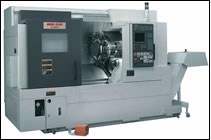New Turning Center Design Aims At Maximum Turning And Milling Rates
Much of machine tool development is based on an incremental approach to design. In such cases, each "new" design is more a refinement of the previous generation of proven technology than a reinvention of the machine type and its purpose. With Mori Seiki's new NL series of turning centers, however, the builder was
Share





Much of machine tool development is based on an incremental approach to design. In such cases, each "new" design is more a refinement of the previous generation of proven technology than a reinvention of the machine type and its purpose. With Mori Seiki's new NL series of turning centers, however, the builder was determined to take a much more fundamental approach, reexamining the dynamics of both the turning and milling processes performed by the machine. In all, a 15-person team spent 2 and a half years on the project, and the company believes the results were well worth the effort.
The primary design criterion was to find the appropriate balance between rigidity and precision, ergo the company's reference to the new machine concept as "R&P technology." What that results in is a machine that permits more aggressive cutting to reduce cycle times without sacrificing quality or tool life to excessive vibration or thermal displacement of critical machine components. The upshot of it all, says the builder, is a machine that can turn parts at dramatically higher cutting rates than prior models and that can mill at rates comparable to a 30-taper machining center.
Central to the machining capability is a new design concept that places the milling spindle right inside the turret. This results in more efficient and rigid transmission of power to the cutting tool. All told, Mori Seiki claims the machine can achieve milling metal removal rates as much as four times that of more conventional turning center designs while maintaining machining center-like accuracy and surface finish. In addition, the elimination of gear or belt drives removes one more source of heat, vibration and noise. All told, Mori Seiki claims the design results in heat generation that is 1/15 of earlier models, vibration and noise are cut in half, and milling spindle acceleration/deceleration rates are three times better.
Of course, the milling spindle motor is itself a source of heat, and a circulating oil jacket is employed to thermally isolate the motor from surrounding machine components. In fact, a great deal of thought has gone into the thermal attributes of the machine design. The machine structure isolates heat radiating from the oil controller and hydraulic unit and applies circulating oil to thermally stabilize the headstock and servomotors.
The NL series design has a "triangle structure" applied to the bed, spindle and tailstock, which is said to increase rigidity and reduce vibration. This is augmented by substantially larger spindle bearings as well as Z- and X-axis ways that are 30 percent wider than earlier models. All of these factors contribute to a 50 percent improvement in overall machine structure rigidity. This markedly enhanced structural rigidity provides the ability to increase cutting rates without sacrificing quality, and to improve tool life as well.
Mori Seiki has documented machine performance with a variety of comparative cutting tests with its own earlier model turn/mill centers. In many cases, the company has found that cycle times can be improved by 30 to 50 percent. Setup time can also be reduced with the servo-controlled tailstock (standard). Moreover, tailstock thrust force can be variably controlled so that, for example, a heavier force can be used for roughing and a lighter force can be used for finishing.
In total, the NL series is offered in 30 different models. There are four sizes—the NL 1500, 2000, 2500 and 3000 respectively with 6-, 8-, 10- or 12-inch chucks. Machine configurations include turning only, C axis plus milling, Y axis, subspindle or any combination thereof. The control features Mori's new MAPPS II operating system, which is said to be faster with 3D graphic cutting simulation and a conversational interface.
Read Next
5 Rules of Thumb for Buying CNC Machine Tools
Use these tips to carefully plan your machine tool purchases and to avoid regretting your decision later.
Read MoreSetting Up the Building Blocks for a Digital Factory
Woodward Inc. spent over a year developing an API to connect machines to its digital factory. Caron Engineering’s MiConnect has cut most of this process while also granting the shop greater access to machine information.
Read MoreBuilding Out a Foundation for Student Machinists
Autodesk and Haas have teamed up to produce an introductory course for students that covers the basics of CAD, CAM and CNC while providing them with a portfolio part.
Read More























.png;maxWidth=300;quality=90)








